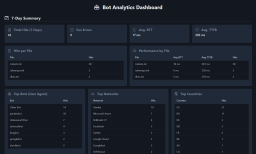Some Experiments into How Google's Crawler works
Why experiment with Googlebot Beyond the fact it is interesting to understand how it works, it is potential useful if you ca...
Expert insights, guides, and tips to improve your website's SEO performance
In the SEO world there's a lot of discussion about whether Search Engines like Google detect and downgrade AI created content. It's a discussion where it's difficult to reach conclusive absolutes. But for the "can it be detected", I previously written about detection and the myth of so called humanizers in the article about our small AI content detector.
The problem Google is solving here is relevant to the question can Google detect AI content, but it's slightly different because ultimately it solves a slightly different problem.
Imagine we are building a LLM and we decide that we will train it on webmaster's content. It's a good deal for us as the LLM builder because it's free, and it's created by humans. Not such a good deal for the author's but that's a different topic. We've trained our LLM well and it produces content that, whilst not indistinguishable from human content to a human observer, is pretty good. Webmasters then start to use that AI to produce articles on their website.
The difficulty now is that to improve our LLM we need to ingest more content. Human content. If we simply scrape the web again then we'll be ingesting LLM content that our LLM itself has outputted. If that worked we could simply have the LLM feed itself its own content all day! But the issue is that it will simply re-enforce its existing errors. The same goes for other LLM models - we would not want their content because it will simply learn competing LLM's errors.
The problem is slightly different. But I hope it's obvious - it means that Google and others are absolutely doing their very best to identify AI content on websites!
SynthID was released by Google in beta in August 2023. It's a kind of watermarking system. Given it was released for general use we can assume Google wants people to use it, which would fit what we talked about above. It's also safe to assume that they are using it on their own products. Or, in short, when you're pumping out your Google generated texts or watermarks you should assume it has a watermark that makes it pretty obvious to AI and search that it is AI generated.
If we read Google's page about SynthID it says the following:
An LLM generates text one token at a time. These tokens can represent a single character, word or part of a phrase. To create a sequence of coherent text, the model predicts the next most likely token to generate. These predictions are based on the preceding words and the probability scores assigned to each potential token. For example, with the phrase “My favorite tropical fruits are __.” The LLM might start completing the sentence with the tokens “mango,” “lychee,” “papaya,” or “durian,” and each token is given a probability score. When there’s a range of different tokens to choose from, SynthID can adjust the probability score of each predicted token, in cases where it won’t compromise the quality, accuracy and creativity of the output.
That description clearly makes it just a form of Steganography. That sort of thing has been done for a long time, and in computing it's no different - you can watermark images, for example, by changing the colors very very slightly of each subsequent pixel so that each one ends with a 0 or 1. Put that back together as binary and you pull the text message out.
SynthID at its core it is the same thing. One major difference is that it only has to encode 1 bit of information (a single 0 or 1). Let's assume 1 means AI. It can do this by changing the probabilities that an LLM will pick certain words next many times. Each one helps then encode a little bit more to the 1. If the model tends to write towards the changed probabilities then it's AI! In practice the whole procedure is a lot more complex.

If you're using AI text and you're a webmaster then the weaknesses will be interesting to you. Like nearly all watermarking systems it will struggle when the text is very short, and specific to this kind of watermarking it will struggle if there is little entropy in the text generation. By this it means if the LLM has very few choices and would always output roughly the same string of text in response. The latter, of course, has some relation to the former given there is simple more opportunity for choices in longer text! But it can also be the case that things that are very factual can lead to less opportunity to encode the watermark.
As a web professional what this probably means for you if you're using Google AI texts is that if you're using them to summarize an article to make a meta description then it probably isn't possible to detect it one way or another. If you're using it to write the whole article then it almost certainly is.
Because this sort of watermarking is encoding a very very small amount of information (AI or not) over quite a large amount of text (like an article) in most cases - editing that isn't very extensive will not remove the watermark, merely lower the confidence. Some documentation suggests that "translation" may count as extensive editing, but it isn't clear if that is the case if the LLM does the translation - I'd assume not and it is more a case of human translation is extensive editing. It's arguable that extensive human editing or translation doesn't leave you with an AI text anymore. Although taking the text to an LLM that doesn't watermark with the same system and translating and translating back would presumably remove the watermark (but likely replace it with its own) - as would be the case for any form of writing.
Just like we observed with the world's smallest AI Text Detector, where it is possible to have a quick pre-scan for likely content and then a second scan to determine it. There is a fast and slower method of detection:
To detect the watermark, you have two options: 1. Use the simple Mean scoring function. This can be done quickly and requires no training. 2. Use the more powerful Bayesian scoring function. This requires training and takes more time.
Or in other words, whilst I wouldn't go so far as to say it is trivial to use this for large scale web content detection - it is pretty easy to pre-pass for likely AI content and go back to check later.
A good question! Whilst we know that every company that is making LLMs must detect AI content and Google is amongst one of those, there's limited information about usage. The original papers do refer to Google using it on Lyria and Gemini. It would make sense that all LLM producers either share detection methods, or have their own which have been reverse engineered by their competitors. Simply because LLM training should not ingest its own outputs.
The major point of this article is to point out that it exists, it is a very real thing, and that you should assume AI content is detectable. The precise specifics for what happens at every search engine and LLM provider, we may never know. What happens with detected content? We can theorize, but don't really know - other than LLM makes don't want to feed it to their own LLMs.
Understanding this high level view of SynthID is useful to understand the large picture and hopefully break some of the myths in the SEO industry. Can AI content be detected - yes, absolutely, with the exception of if it is very short.
Start with a free crawl of up to 1,000 URLs and get actionable insights today.
Try The Crawl Tool Free
Why experiment with Googlebot Beyond the fact it is interesting to understand how it works, it is potential useful if you ca...

LLMS.TXT again I've written about LLMS.TXT in the article about how getting one listed in an llms.txt directory mysteriously...

What's this about Adding Other Media to robots.txt I recently came across John Mueller's (a Google Search advocate) blog. I ...

Understanding the Importance of having a fast Mobile website I, personally, spend a lot of time focusing on site speed. The ...

What are robots.txt, sitemap.xml, and llms.txt These files are used by search engines and bots to discover content and to le...

AI Crawlers and Citing Sources The rise of AI, rather than search, crawlers visiting websites and "indexing" information is ...